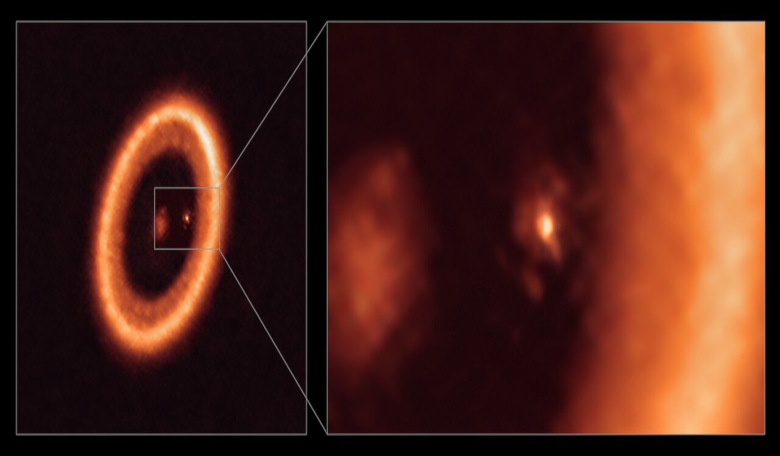For the first time, astronomers have unambiguously detected the clear presence of a moon-forming region around a giant Jupier-like exoplanet 400 light years away; a finding that will help shed new light on how moons and planets form in young stellar systems.
With around 66 radio telescopes that are capable of detecting faint radio waves given off by tiny particles of dust, the Atacama Large Millimetre/submillimetre Array (ALMA) is perfectly poised to peer past the glare of a bright star and pick out forming planets nearby.
The array has already helped scientists see planets being “born” in protoplanetary disks around fledgling stars and now it has gone one better by detecting the presence of something much smaller; a disk around a planet known as a circumplanetary disc.
The disk in question surrounds one of two massive exoplanets orbiting a young star known as PDS 70.
PDS 70 had already been flagged up as a potentially interesting system when in 2019, astronomers found compelling evidence that a dusty disk capable of forming multiple moons was surrounding the outermost known planet, PDS 70c, which is located approximately 5.3 billion kilometres from its host star – around the same distance as Neptune is from our Sun.
At the time, a team led by Andrea Isella, an astronomer at Rice University in Houston, Texas, could not clearly distinguish the disc around PSD 70c from its surrounding environment.
But, a couple of years down the line and lots more observations with ALMA, a different team, this time led by Myriam Benisty, a researcher at the University of Grenoble, France, and at the University of Chile, have been able to hone in and see a clear separation.
“Our work presents a clear detection of a disc in which satellites could be forming,” Benisty says. “Our ALMA observations were obtained at such exquisite resolution that we could clearly identify that the disc is associated with the planet and we are able to constrain its size for the first time,” she adds.
It turns out that the disc has about the same diameter as the distance from our Sun to the Earth and enough mass to form up to three satellites the size of the Moon.
Scientists know that as planets begin to grow, they carve out cavities in a protoplanetary disk as the gobble up surrounding material.
As they leave these tell-tale gaps in the disk, planets can also acquire their own circumplanetary disc, which contributes to the growth of the planet by regulating the amount of material falling onto it.
At the same time, the gas and dust in the circumplanetary disc can come together into progressively larger bodies through multiple collisions, ultimately leading to the birth of moons.
But the details of this process are still a bit hazy and it is unclear when, where, and how planets and moons form. PDS 70c could help change that however as it offers scientists a unique opportunity to observe and study the processes of planet and satellite formation, says Stefano Facchini, a ESO Research Fellow also involved in the research.
The same cannot be said for PDS 70c’s companion, PDS 70b, though.
PDS 70b is closer in and orbits about the same distance away that Uranus does from our Sun, but the new ALMA observations indicate that PDS 70b does not show clear evidence of such a disk, suggesting that it was starved of dust material from its birth environment by PDS 70c.
To get an even better look at the system, the team will have to wait until ESO's Extremely Large Telescope (ELT), which is currently under construction on Cerro Armazones in the Chilean Atacama desert, becomes operational.
Once it does it will have much higher resolution and when used with the ELT's Mid-infrared ELT Imager and Spectrograph (METIS), the team will be able to look at the gas motions surrounding PDS 70c to get a full 3D picture of the system.











